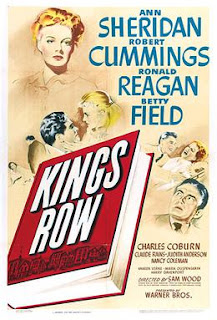One of the things I enjoy about the pre-Code films like
Three on a Match (1932), which I watched this morning, is that they often have fairly short running times by the standards of Hollywood theatrical features.
Three on a Match, for example, runs just 62 minutes, and packs a lot in to that length. As a result, it's fully engaging for that duration, and is easy to watch casually without having to commit too much time to it.
I watch a lot of B movies while working out at the gym, because the roughly hour-long running time is perfectly suited to the amount of time I spend on the exercise equipment, where I watch the film on my phone. And the relatively simple and straightforward plots do not require a great deal of attention.
Three on a Match is not a B movie, really, but a smaller film from a major studio (in this case, Warner Bros.) In those days, the studios could release a 60 minute feature because it would be part of a program with shorts and other supplemental films, and after the emergence of double features, B movies provided the second half of the program.
Thinking about it, though, there were still some big studio "A" pictures that had short running times: Intermezzo (1939) ran 70 minutes, Nothing Sacred runs 77 minutes, The Ox-Bow Incident (1943) and Roxie Hart (1942) were both 75 minutes, and Preston Sturges' Christmas in July (1940) was just 68 minutes. The shorter lengths were more common with comedies: Laurel and Hardy made a couple of features that ran just under an hour, and W.C. Fields made one that ran 58 minutes. Alfred Hitchcock's Rope ran 80 minutes.
The term "featurette" was used to refer to these movies that ran longer than a short film, but shorter than the usual full-length. Hal Roach had a whole series of "streamliners", as he called them, in the 1940s. I've seen a few of these, and the running time works quite well for these comedies.
Anyway, I could go on, but the point is there were plenty of commercially-released feature films during the '30s and '40s that ran around the hour mark. It seems that once double features started to disappear in the '50s, films began to get longer in general. It seems that 70 minutes was sort of the extreme end of a short feature by the '50s and '60s, maybe reserved mostly for drive-in fare that would often be shown on a larger program. I remember in Ed Wood, the producer of Glen or Glenda tells Wood that he just has to make the film 70 minutes long in order for him to sell it. I think Corman's Little Shop of Horrors (1960) runs 69 minutes.
More recently, it seems like anything less than 90 minutes for a commercial theatrical feature is pretty rare. Most of the films I've seen in theaters in recent years are closer to 2 hours, with many running longer than that. Comedies may be an exception, but even those seem to have gotten quite a bit longer. I'd say generally that anything over 90 minutes for a comedy is really too long, and anything over two hours is lethal. Billy Wilder made some comedies like Some Like it Hot and The Apartment that ran over two hours, but I think in those cases he justified the length. And of course there was It's a Mad Mad Mad Mad World. I was astonished to see some of Judd Apatow's movies running over two hours in length, and I remember being similarly amazed that The Blues Brothers ran nearly two-and-a-quarter hours, though that was largely due to the music numbers.
I read that John Waters had a rule that his movies should never be longer than 90 minutes, and indeed they've all been in that range. It seems like a good strategy when you're aiming for theatrical release. Also it forces you to be judicious in your editing and really be more economic in what you're trying to accomplish.
I've seen some short, independent features on YouTube that ran around an hour or just over. These tend to be mostly improvised films shot in a single location with a limited number of actors, which can be quite effective. It's interesting to contrast these, though, with some of the B movies of old, which would pack so much in to their short running time. I would say that unless the material justifies it, even 60-70 minutes can be quite long for a truly no-budget film. It seems like streaming video really opens up the possibilities for micro-short films.




























